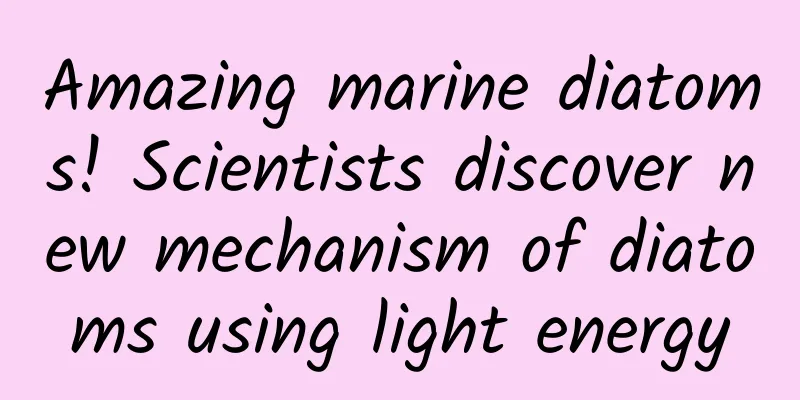Amazing marine diatoms! Scientists discover new mechanism of diatoms using light energy

|
Produced by: Science Popularization China Author: Zhou Lu Gaoshan (Institute of Oceanology, Chinese Academy of Sciences) Producer: China Science Expo When it comes to the food chain, most people will automatically think of the phrase "big fish eat small fish, small fish eat shrimps." However, have you ever thought about what shrimps eat, and small fish eat shrimps? Various fish in the ocean (Photo source: Veer Gallery) In fact, there are many "indigenous people" in the ocean that are smaller than shrimps and even invisible to the naked eye, that is, various microorganisms, which shrimps eat by filter feeding (similar to drinking water). However, it is these microorganisms at the bottom of the marine food web, especially phytoplankton, that support the entire marine ecosystem with their tiny bodies all the time and play the role of producers. Diatoms and dinoflagellates in the ocean are a pair of tireless and distinctive competitors. They provide food sources for marine animals and are indispensable. However, for human activities, they are also the leaders of red tides, especially dinoflagellate red tides, which often cause great damage in aquaculture production. Therefore, how to eliminate toxic red tides has become a headache. As the saying goes, knowing yourself and your enemy ensures victory in a hundred battles. If we want to effectively eliminate toxic red tides, we must first have a deep understanding of these natural competitors. Deadly dinoflagellates - makers of burial objects Every summer, when we open our phones and surf the Internet on various social platforms, we see various news reports, long and short videos, etc. about "blue tears" and "fluorescent sea". "Blue tears" and "fluorescent sea" also attract many tourists to take photos and watch with their "beauty". The microorganism that causes this wonder, Noctiluca scintillans, is also a dinoflagellate. **Because Noctiluca scintillans contains a large amount of fluorescein, it will glow when stimulated,** thus forming a fairyland-like dreamy effect of "blue tears" and "fluorescent sea". "Blue Tears" (Photo source: Veer Gallery) "Blue Tears" (Photo source: Veer Gallery) However, don’t be fooled by this gorgeous appearance, as the outbreak of dinoflagellate red tides is often accompanied by the production of a large number of toxins. Although dinoflagellates can be used as bait for fish larvae, some groups of dinoflagellates can produce a variety of toxins. For example, ciguatera toxin is a representative of the polyether toxins produced by dinoflagellates. As an agonist of voltage-dependent Na+ channels, ciguatera toxin can increase the permeability of cell membranes to Na+, produce strong depolarization, and cause changes in neuromuscular excitability conduction, thereby causing nerve numbness, metabolic disorders and respiratory disorders in fish, and ultimately leading to mass deaths of fish. In areas prone to red tides, the algal toxins released after the death of dinoflagellates can cause great harm to fish and shellfish in the water, making them the victims of the dinoflagellates, thus causing huge economic losses in the fishery sector. Breaking waves show signs of "red tide" (Photo source: Veer Gallery) Since the harm caused by dinoflagellate red tide is so serious, how should we control it? Chemical algaecides are generally used for spraying in fisheries, however, the dosage and side effects of the drugs are difficult to control. In addition, there is another way to control it naturally, which is to promote the transformation of toxic red tides into non-toxic red tides. Scientists have found through research that N/P can indicate the nutritional status of the water body during the red tide, and is an important indicator of algae being limited by N or P. The N/P required for the growth of different algae is different and may be specific, and the limitation of each nutrient element usually determines the outcome of competition among algae. Therefore, by adjusting the N/P of the water body, harmless competitors, especially diatoms, can be helped to take the lead in this phytoplankton outbreak. Universal diatoms - the king of marine involution Diatoms are full of treasures. When alive, diatoms are important aquaculture bait, especially shellfish larvae, such as triangular brown finger algae, small crescent-shaped algae, etc., which have the advantages of rich and balanced nutrition, low cost, easy digestion and the ability to purify water. At the same time, diatoms are also rich in oil and fat, and are the star raw material organisms for the production of biodiesel. In addition, diatoms have accumulated many bioactive substances that are beneficial to human health, such as fucoxanthin, golden algae kelp polysaccharide, long-chain polyunsaturated fatty acids eicosapentaenoic acid (EPA) and docosahexaenoic acid (DHA), etc. Most of them have been used in the production of medicines or health products. Because of its unique siliceous shell, diatoms are also selected by scientists to make drug carriers for targeted therapy. Diatoms have so many functions when alive, and they also play an important role after death. After death, diatoms are also the raw materials of submarine oil and one of the exploration markers. In addition, its cell wall can be made into diatomite products, such as the practical diatomite absorbent pads that can be bought daily. Even if diatoms are in a static state, their unique, beautiful and rich appearance will be favored by artists. In other words, diatoms are simply the legendary "good-looking and hard-working children from other people's families." Diatoms are not only "involuted", they are also very "individual". Unlike the green plants we are familiar with, diatoms have always evolved in the ocean, so they have taken a unique evolutionary path - secondary endosymbiosis . This unique evolutionary route stems from the two engulfments of organisms. It is generally believed that the first engulfment of prokaryotes by eukaryotes gave rise to the autonomously replicating membrane organelles chloroplasts and mitochondria in cells. Due to the secondary engulfment, the chloroplast membrane of diatoms is doubled, that is, it has four layers. Although diatoms have such unique chloroplasts, their photosynthetic capacity is very strong. Diatoms are distributed from the dark seabed thousands of meters deep to the dazzling sea surface. Whether it is weak light or super strong light, diatoms can use it very effectively. This is one of the core competitiveness of diatoms to become the "king of the ocean". The strong photosynthetic capacity supports diatoms to complete the "performance" of providing more than 20% of the world's primary productivity. What goes up, what goes down: seasonal succession of phytoplankton Stretching in spring and sleeping in winter, while we adapt to and enjoy the wonderful changes of four seasons on Earth, these ancient microorganisms are also experiencing the changes of the seasons. As the "king of the ocean", diatoms tend to dominate the sea area as long as the external environmental conditions are suitable. Therefore, in early spring, as the sea ice melts, diatoms are the first "model workers" to get up and work, that is, the pioneer algae . Summer is mainly the period of large-scale outbreaks of dinoflagellates. At this time, diatoms have begun to "nap" and decline, and will return to their "old nest" (Antarctic sediments) in winter. Throughout the year, although the seasonal alternation of diatoms shows such a trend, it is not ruled out that the diatoms often "roll up" and form an outbreak in spring. However, the rise of diatoms is inseparable from the "shoulders of giants" - the outbreak of diatoms, that is, the pioneering position of diatoms is always difficult to shake. Time flies, the stars change, and the seasonal alternation of diatoms and dinoflagellates has remained unchanged. Scientists have used temperature, nutrition, wind and other factors to explain why dinoflagellates came later and why diatoms declined. However, scientists have not found the key clues to reveal the pioneering diatom outbreaks. This makes us wonder: Are there other clues that have been overlooked? Or do we need to integrate these fragmented clues? The ignored KPI - WoLight In order to solve these problems, plant scientists, especially researchers dedicated to improving crop resistance and yield, have gradually turned their attention to an overlooked external environmental factor - fluctuating light. In nature, light is not constant. Factors such as the shade of leaf canopies and the movement of clouds can reduce the intensity of sunlight from 100% to 10%. Therefore, photosynthetic organisms are always facing the threat of fluctuating light. In order to cope with this stress, they must evolve multiple mechanisms to respond. In fact, the fluctuating light environment in the ocean is even more severe. Due to the influence of waves, turbulence, internal waves, etc., phytoplankton is constantly facing violent vertical movement. Therefore, marine algae are frequently exposed to fluctuations from saturated sunlight to dim environments. Some sea areas can even produce changes from 100% saturated sunlight intensity to 1% within a half-meter depth. It can be seen that compared with land, lakes and rivers, the light environment in the ocean is more variable and complex, which is a huge challenge for marine photosynthetic organisms. Based on the ocean monitoring data, scientists simulated different intensities of fluctuating light levels and found that diatoms have more efficient photosynthesis than dinoflagellates under fluctuating light and grow faster. This also shows that diatoms have a "complete victory" over dinoflagellates in terms of adapting to and utilizing fluctuating light. So how do diatoms defeat their opponents and have such a strong ability to resist fluctuating light? Scientists have used a series of methods, including gene editing, photosynthetic electron transfer assays, inhibitors, microscopic observations, cell staining, transcriptomics and metabolomics, isotope-labeled metabolic flux analysis, etc. (in short, try to work as hard as diatoms), and found that in diatoms, PGR5/PGRL1, a pair of key photosynthetic stress resistance proteins, plays a key role, and marveled at the cleverness of diatoms, that is, they adopt different coping strategies under weak and strong fluctuating light. Under the conditions of intense fluctuating light that only occur in the ocean, the PGR5 protein will have a significant response, and the photosynthesis of diatoms will be adjusted, and the photosynthetic oxygen release capacity will be stronger, so that more oil can be accumulated, further improving their competitiveness. Conclusion Diatoms are smart in adopting different strategies under different light fluctuations, and humans are smart in controlling dinoflagellate red tides by adjusting the N/P ratio of water bodies. With the help of science and technology, humans continue to understand nature and transform it within a reasonable range. I believe that in the future, we will be closer to nature and have a closer connection with it. Editor: Ying Yike References: 【1】Dutkiewicz A, Muller RD, O'Callaghan S, Jonasson H. Census of seafloor sediments in the world's ocean[J]. Geology, 2015, 43 (9):795-798. 【2】Zhou L, Gao S, Wu S, Han D, Wang H, Gu W, Hu Q, Wang J, Wang G. PGRL1 overexpression in Phaeodactylum tricornutum inhibits growth and reduces apparent PSII activity[J]. The Plant Journal, 2020, 103 (5):1850-1857. 【3】Zhou L, Wu SC, Gu WH, Wang LJ, Wang J, Gao S, Wang GC. Photosynthesis acclimation under severely fluctuating light conditions allows faster growth of diatoms compared with dinoflagellates[J]. BMC Plant Biology, 2021, 21:164. 【4】Zhou L, Gao S, Yang W, Wu S, Huan L, Xie X, Wang X, Lin S, Wang G (2022) Transcriptomic and metabolic signatures of diatom plasticity to light fluctuations. Plant Physiol. |
<<: It’s only the 28th, how come it’s already the end of the month?
>>: Why do only Chinese people like to drink hot water? Is "drinking more hot water" really useful?
Recommend
The fighting power of "autumn mosquitoes" is off the charts. Let's have a "mosquito-killing" storm! See the "vicious" flowers
After finally getting through the summer mosquito...
"Food Safety Guide" Series | In which foods are aflatoxin likely to "hide"? Learn more in one article
Aflatoxin is the most common mold in warm regions...
21 most commonly used growth techniques by foreign growth hackers
After testing and practicing throughout 2017, for...
Douyin Teacher Li's Mathematical Thinking Course (Grades 1-3)
: : : : : : : : : : : : : : : : : : : : : : : : : ...
Tips for attracting new users on Pinduoduo APP!
This article is an analysis of Pinduoduo's ca...
How to plan a marketing campaign that reaches 1 million people
When I first learned about the event, I actually ...
Controlling sugar does not mean quitting sugar, the real sugar control manual is here!
《Cotton Swab Medical Science Popularization》 Tao ...
Win10 Build 10074 hands-on: a lot of changes
Windows 10 Build 10074 was leaked from Microsoft&...
When buying a mobile phone in 2021, master the "four no-needs" principle and don't choose blindly
1. You don’t have to choose the latest flagship p...
The Baidu Yinchuan Mini Program failed the review and it was prompted that the Baidu Mini Program does not currently include this type of product. What should I do?
1.Q: The business entity or special qualification...
Li Xiang, founder of Autohome: FF91 is great but delivery is a big problem
Recently, Faraday Future, invested by LeEco, offi...
How to plan a professional online event?
Planning an event is not an easy task. It is esse...
Windows Phone's itch for domestic market share
Windows Phone (abbreviated as WP) is a mobile pho...
Zhang Hailiang joins the electric star Jia Yueting's LeTV car ecosystem shrinks across the board
The news that LeEco Auto CEO Zhang Hailiang offic...
Celebrities aren’t the only ones who get doxed. Learn these tips to protect your online privacy
When it comes to human flesh searches, people oft...









